July 24, 2003
Revisions to PS<->D
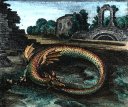 | This is the dragon which devours its own tail.
|
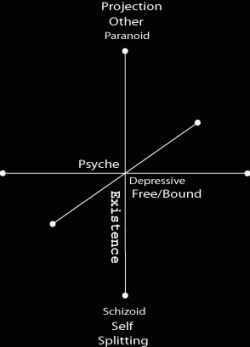
In Alpha Function we mentioned revising the conception of the classical paranoid-schizoid and depressive positions using the more sophisticated model of human experience provided by the Cube of Psychological Space. In the classical formulation of Melanie Klein, these concepts describe both developmental states in infancy and a metapsychology of of early mental processess and instinctual development. The paranoid-schizoid position is the initial psycho-physical state of the baby, characterized by mechanisms of splitting and projection, omnipotent and destructive phantasies and part-object relationships (good breast/bad breast). The paranoid-schizoid is gradually phased out and replaced with the depressive position, as the baby learns to tolerate frustration and, depending on the amount of death instinct he or she has inherited in the form of excessive greed and envy, moves toward a realm of whole objects through the depressing realization that the world isn't all it was cracked up to be. Further disappointments lie ahead in the Oedipal stage as whole object relationships are developed and explored, and the ego (and sexual identity) is formed out of renounced object-cathexes (Freud).
|
|
Bion (projective identification) and Winnicott (transitional space) extended these concepts into the intersubjective realm and both recognized "healthy" forms of projective identification, i.e. the persistence of paranoid-schizoid processes as the basis for normal development and creativity. Psychoanalytic theory, which is the history of its resistance to intersubjectivity, seems to have reached the dead end of an over-extended and out-moded metapsychology of intra-subjective experience. It cannot assimilate its own insights into the therapeutic framework and counter-transference, and has no metapsychological framework for integrating its observations about inter-subjective phenomena. PS<->D to P<->D<->S. Here we explore just one axis of the Cube of Space, the vertical or existential axis. The Cube is a diagram or model of the multi-dimensional totality of human psychological experience. The vertical axis, analyzed by George Lakoff in Metaphors We Live By (Orientational Metaphors) and Jacques Chevalier in The Corpus and the Cortex, qualifies our experience of existence as up and down, good and bad, right and wrong, life and death, conscious and unconscious, more and less, rational and emotional (Lakoff) and right and wrong, pleasure and pain, lawful and lawless, levels of attention, judgments and emotions (Chevalier). We suggest that the root metaphor of up-down is our ex-is-tence as spirit and matter, our standing and place in the world, characterized by the polarities of self and body/other. This metaphor is clearly behind intersubjective psychoanalytic thinking, with its superegos and ids, projectition and splitting, infra and infer alter-egos, mirroring and idealizing transferences. The problem is that the components of the vertical axis are not clearly distinguished and identified. Klein lumps paranoia and schizoid phenomena together and sees depression as a later development. P: Paranoia and projection obviously have to do with the other (hysteria is a projection onto the body as other). The psyche/ego mediates between the energies of superinfraalteregoother and Now that we can see that P and S are opposite poles of existence united by the D of psyche/ego, PS->D or PS<->D can be differentiated into P<->D<->S. Notice we also differentiate self and object representations from the central ego or psyche and say nothing of consciousness or unconsciousness. Freud's Id is a narrow definition of the material basis of the self and its developmental (instinctual) goals. It is no more unconscious than any of the other unconscious energies that inform our experience of life in existence. Its direct descendents are seen in the development of the concepts self-objects, mirroring and idealizing transferences and self-psychology. PS or P<->S is the basic self-object polarity of existence. Pathologies of self relations (splitting, schizoid phenomena) and pathologies of object (why not say "other"?) relations (paranoia, positive and negative idealization) reflect imbalance or damage to either or both sides of the unit. D aka the psyche or experiencing ego is a position only in its centrality. Its integrative and dissociative functions are operative from birth. Its pathologies are mania and depression, as the central psyche tries to deal with damage to the self-object unit. P<->D<->S or object-representations <-> psyche <-> self-representations describes both the structure and dynamic of existence, present from birth. Healthy development would minimize trauma and pathology in all three positions. The depressive "position," supposedly occuring in later infancy and marking the beginning of whole-object relations, would seem to point toward a structuring of the central ego or psyche.
|
July 20, 2003
Slouching Towards Bethlehem
Turning and turning in the widening gyre The Falcon cannot hear the Falconer; Things fall apart; the centre cannot hold; Mere anarchy is loosed upon the world, The blood dimmed tide is loosed, and everywhere The ceremony of innocence is drowned; The best lack all conviction, while the worst are full of passionate intensity. (The Second Coming - W. B. Yeats) |
This paper, therefore, offers and explicates the following hypotheses linking leadership capacity to depressive position resolutions on the one hand, and its role in maintaining the moral order by working to hold the center, on the other. Hypothesis: The achievement of enlightened values, and hence enlightened leadership, depends on the depth and stability of depressive position resolutions, and the capacity to maintain them under conditions of emotional duress (see, for example, Adorno, et. al. "The Authoritarian Personality" which make a powerful case for the essential lack of values that characterize a personality configuration dominated by splitting and the preponderance of a paranoid/schizoid mental states). Subsidiary Hypothesis 1.: With respect to leadership, the greater the regression from depressive position states of mind, the greater the departure from moral behavior. This means that splitting and denial represent greater lapses than sublimation or intellectualization (note that repression, suppression and displacement occupy the middle range). Put another way, primitive defenses associated with paranoid/schizoid states of mind are not only anti-task, they are "anti-moral", as well, with all of the obvious implications for the nature of society and its institutions." Subsidiary Hypothesis 2.: All primitive defenses are lapses from the moral order, but in their sophisticated, adaptive form (in Bion's view), necessary for individual and group survival. Therefore, the inherent nature of individual and collective psychology is a constraint on the continuous maintenance of an ideal moral state. |
Projective Identification and Containment
19th Annual Conference on the Psychology of the Self: Reconceptualizing the Clinical Experience |
July 18, 2003
Theory & Practice
|
Animal intelligence. Don't miss the movie. Words Stunning Hubble pictures Emerging social networks Can't happen here department |
Psychoanalytic Development
Freud: His Life and Thought |
July 16, 2003
Today's links

Aum
Archives
Merlot: Multimedia Educational Resource for Learning and Online Teaching
Consciousness
Science And Consciousness Review
Blogs
Metafilter: Lo-Fi Summaries
Submit Response: blog-oriented blog
Rageboy: Headbone Disconnected From De Brain...bone
Dr. Menlo daily blog gyrations
Egypt
The World's oldest puzzle on Osiris Numbers
Miscellaneous
Clandestina: Lucid Dreams
Japanese Old Photographs in Bakumatsu-Meiji Period
The Truth is What You Believe: graphic novella
Scott McCloud: The Right Number: online graphic novella
Similarities Throughout Religions (Same Message different Words
Blacktriangle: Pharmaceutical related talk about medicines and adverse drug reactions
aeternus: urban anthropology (pinhole camera photographs)
New Scientist: Masturbating may protect against prostate cancer
The True Bible Code is a Symbolic Code. The ELS Hebrew 'Bible Code' is a fake
Mathematicians' Statement on the Bible Codes
Assassinations Foretold in Moby Dick!
Philosophy
Introduction to Philosophical Reasoning
Politics and News
George W Bush Resume
Follow That Story: The Nuclear Whodunit, Part 4
BBC: Core of weapons case crumbling
Berkshire Eagle: Why does 9/11 inquiry scare Bush?
RepentantNaderVoter: because Bush is so bad (TweedleDee became a global tyrant)
William Greider: Little Caesar's Quicksand
Daily Times: EDITORIAL: Washington\222s web of deceit
Rising Doubts: President Facing New Challenges of Credibility and Casualties
Brent Cunningham: Rethinking Objective Journalism
20 Lies About the War
Trading on fear
Blair is defiant to the end. But is the end in sight?
CIA Got Uranium Reference Cut in Oct.
Bush-Cheney '04: Donor Search
Psychology
Jon Mills: Dialectical Psychoanalysis: Toward Process Psychology
Psychology and Biblical Studies
Highlights of the Psychoanalytic Literature: A Topical Reading List
IJP: Richard Lucas: The Relationship Between Psychoanalysis and Schizophrenia
karnacbooks: Search British Psychoanalysis titles
Review: Unfree Associations: Inside Psychoanalytic Institutes
Psyche Matters: Bion's War Memoirs: A Psycho-analytical Commentary
In the Beginning was the Word: Projective Identification
Robert M Young: Descriptive versus Dynamic Concepts of Psychotherapy
Marilyn Charles: "Confusion of Tongues": Difficulties in Conceptualizing Development in Psychoanalytic Theories
Qabala
Design Language: Charles S Peirce and the cabbala
Reference:
Browser Wars II: The Saga Continues
PDF: Unfit for Human Consumption
elearnspace: The Fuss about RSS -- Summary
Brad Templeton: 10 Big Myths about copyright explained Reverse-Proxy Spam Trojan - Migmaf
Hypertext Now: serious hypertext | link types: a second look
Randall Trigg: A Network-Based Approach to
Text Handling for the Online Scientific Community
Words
Wordmax: Common Errors in English
July 13, 2003
Perspective
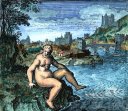 | The one of the philosophers is dropsical and wants to be washed seven times in the river, just as Naaman, the leper, washed in the Jordan. |

 |
"Perspective is of fundamental importance for several reasons. As a systematic method of representation it is one of the distinguishing characteristics of advanced technological societies. In the Renaissance it was an example par excellence of western achievement."
The Sources and Literature of Perspective
| We tend to forget that people did not always see the world the way we do. A good example is the phenomenon of the development of 3-D perspective in the Rensaissance, which transformed how we represent the world to ourselves.
Filippo Brunelleschi discovered Linear perspective in the early 15th century. More than an artistic technique, the development of perspective is a foundation for both modern technology and psychology. Technologically, perspective is a basis for empiricism and the rise of the scientific method. Psychologically, perspective put the individual at the center of his/her experience for the first time in history, and freed thought and imagery from the static plane. This is a giant step forward, not only in being able to "see" in three dimensions, but in creating a "virtual" reality inside a "virtual" space -- as the metaphoric representation of human psychological reality. |
Getty Museum: The Geometry of Seeing: Perspective and the Dawn of Virtual Space
"Next, Grotstein extends Bion’s observation that the "container-contained" relationship presupposes notions of psychic space or "inner space" - the relation between the mind and the contents it houses: "all psychopathology can be thought of as conditions or states in which the patient experiences a sense of being trapped within a psychic space that is characterized as the zero, first, or second dimensions" (p. 84). Grotstein likens the "null" dimension to a single point on a Cartesian, polar-co-ordinated graph. The null dimension of space is infinite and timeless; it correlates to phenomena such as solipsism, fusion, and concretization. The first dimension introduces a basic concept of separation, a self-other distinction that involves time and distance. Grotstein depicts the first dimension as a line on a polar co-ordinated graph. In keeping with the paranoid-schizoid position, the first dimension permits no degrees or margins of ambiguity – the approach of the good mother presupposes the departure of the bad mother and vice versa. If the infant feels depleted and hungry, then mother’s breasts must necessarily be full. The second dimension, a line now extended to a plane, is two-dimensional and depthless. It correlates to the phenomena of flattened states, phenomena such as depression and apathy, tired clichés and lifeless conventionality. Finally, Grotstein refers to a third dimension of depth characterized by a movement into whole object relations, a greater acceptance of separation, an understanding of the multiple origins of causality and an appreciation of symbolism."
Keith Haartman: Review: James Grotstein: Who is the Dreamer Who Dreams the Dream
Erwin Panofsky's explanation of Iconography and Iconology
Quotes from the book The Psychology of Perspective and Renaissance Art by Michael Kubovy
Piero della Francesca and the Two Methods of Renaissance Perspective
Computers and Renaissance Perspective
Nina Joblon: Power, Illusion, and the Technology of Perspective in the Renaissance
Renaissance Perspective Examples
July 10, 2003
Transitional Space
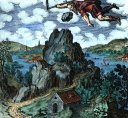 | The Stone that Saturn vomited up after having devoured it in place of his son Jupiter, has been placed on the Helicon as a souvenir for the mortals. |
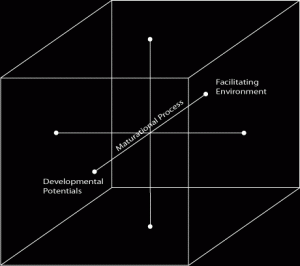
| Donald W. Winnicott published Transitional Objects and Transitional Phenomena in 1951. Transitional space is a condensation of Winnicott's ideas of potential space and transitional phenomena. Potential space is the overlapping space between two individuals, neither subject nor object but some of both. In this space we find transitional objects and transitional phenomena.
Winnicott, writing at mid-last-century, is the major transitional figure in the development of psychoanalytic theory. A pediatrician and child psychiatrist with high-risk trauma survivors, Winnicott had no use for a death instinct or Klein's projective introjection of a bad (envious, greedy) baby, and instead saw the mirroring interchange of imaginative play in the transitional space between mother and child as the basis of creativity. Winnicott laid the groundwork for the narcissistic and borderline personality and self-psychology theorists who populated the 1970's and 80's.
Memes: Mirroring. Good-enough mother. Potential space. Transitional phenomena and objects. True and false self. Maturational process. Facilitating environment. Environmental mother. Optimal adaptive failure. Playing and Reality. Squiggles. Advice for therapists: Keep alive. Keep well. Keep awake. The Aims of Psychoanalytic Treatment (1962).
|
"Where Freud saw psychoanalysis as a way of freeing people from illusions, Winnicott emphasized the freedom to create and enjoy illusions. Whereas classical technique centered on the value of interpretations, Winnicott pointed to the value of not interpreting. Where classical theory had explored the infantile fear of being alone, Winnicott spoke of the mature capacity to be alone. Regression, rather than being pathological in that it provides a surfeit of infantile gratification, becomes, in Winnicott's hands, a process of healing through a search for missing experiences. Psychosomatic illness was not a withdrawal of interest from the outside world, as classical theory claimed, but an attempt to rediscover one's own body. Within psychoanalysis, Winnicott represented a shift in emphasis from patterns of gratification, frustration, and sublimation to how meaningful and authentic is a person's experience and expression of himself. As he once remarked to Harry Guntrip: "We disagree with Freud. He was for curing symptoms. We are concerned with whole living and loving persons." As a result, Winnicott shifted the focus from the way in which people negotiate the family triangle to how individuals gradually acquire personhood as they separate themselves out from, while remaining connected to, mother's embrace. Put differently: it is the developing person's relationship to the instinct rather than the development of the instinct within the person that most concerned Winnicott. That is why his work constitutes a turning point."
D.W. Winnicott by Robert Prince
Dodi Goldman: D.W. Winnicott's "Mirror-Role of Mother a nd Family in Child Development"
"Klein's biographer reports that until he wrote 'Transitional Objects and Transitional Phenomena' in 1951, Winnicott considered himself a Kleinian. He wrote it for inclusion in the classical collection of Kleinianism, New Directions in Psycho-Analysis (1955). She wanted him to revise it so as to incorporate her ideas more clearly, and he refused. As far as Klein was concerned, that was the end of their relationship, although he remained committed to certain of her ideas, particularly the depressive position, while disagreeing about the death instinct, the paranoid-schizoid position and innate envy (Grosskurth, 1985, pp. 397-8; cf. pp. 399-400). "
Robert M Young: Potential Space: Transitional Phenomena
Winnicott.net: A place for the scientific exchange of D. W. Winnicott's theory
Review: Belief and Imagination: Explorations in Psychoanalysis by Ronald Britton
Sharon Dolin: "Bitter and Delicious Relations": The Transitional Object in Williams's Poetry
July 06, 2003
Container and Contained
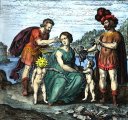 | Make Latona white and tear up the books. |

"The signs  and
and  I call the contained and the container. The use of the male and female symbols is deliberate but must not be taken to mean that other than sexual implications are excluded. These signs designate a relationship, between
I call the contained and the container. The use of the male and female symbols is deliberate but must not be taken to mean that other than sexual implications are excluded. These signs designate a relationship, between  and
and  . The link may be commensal, symbiotic or parasitic." Bion, Attention and Interpretation, p.107
. The link may be commensal, symbiotic or parasitic." Bion, Attention and Interpretation, p.107
"I propose provisionally to represent the apparatus for thinking by the sign 
 ." Bion, Elements of Psychoanalysis, p.31
." Bion, Elements of Psychoanalysis, p.31
A dot and a circle would have been better choices than   which should be reserved for other usages. Bion used the concept of container-contained to extend, or rather follow to the logical conclusion, Melanie Klein's idea of projective identification. If there is a projection, where does it go? The problem with this is that psychoanalysis has no metapsychology for intersubjective relationships, and simple concepts formulated fifty plus years ago like Klein's projective identification, Bion's container-contained, and Winnicott's holding environment, all milestones on the way to recognizing the reality of relationship, are still met with fierce resistance. which should be reserved for other usages. Bion used the concept of container-contained to extend, or rather follow to the logical conclusion, Melanie Klein's idea of projective identification. If there is a projection, where does it go? The problem with this is that psychoanalysis has no metapsychology for intersubjective relationships, and simple concepts formulated fifty plus years ago like Klein's projective identification, Bion's container-contained, and Winnicott's holding environment, all milestones on the way to recognizing the reality of relationship, are still met with fierce resistance.
Container-contained is a bigger concept than the sexual conjunction, and so is thinking. Bion seems to be conflating or confusing several ideas -- male/female, active/passive and container/contained which should be differentiated. Containers, for instance, (as he says) can be both active and passive. |
Wilfred Ruprecht Bion: Bibliography
| Quotes from Arno Leo Goudsmit's via negativa Towards a negative understanding of psychotherapy, Chapter 11: Some notes on projective identification, which situate the interpersonal concept of container-container in psychoanalytic theory. |
"A major theoretical and clinical extension to Klein’s work has been made by Bion (1959, 1962b), himself a Kleinian, when he distinguished two types of projective identification, a malicious one for the sake of ’evacuation’, and a healthy one for the sake of ’communication’. "The difference depends on the degree of violence in the execution of the mechanism" (Hinshelwood, 1991, p. 184). Subsequently a great number of differentiations have been proposed with regard to the various dimensions of projective identification (e.g. Grinberg, 1979, p. 228). Hinshelwood points at the various interpersonal interpretations of the concept of projective identification, as by Ogden (1982), and at the criticism that such interpretations generate in circles of more orthodox object relation theorists.
Several grounds can be found for the existence of the opposition between the ’orthodox’ kleinians, who stuck to understanding projective identification in terms of unconscious phantasies, and others more interested in applying the term to interpersonal behavior patterns. Though the parties agree that projective identification happens within an interpersonal context, the Kleinians prefer to see it as a phenomenon that takes place at the level of "the use to which the analyst is put in being unwittingly drawn into the patient’s phantasy world." (Hinshelwood, 1991, p. 200). In other words, it is a phenomenon that befalls the therapist, in which he is made witness of some experience of his patient, in a way that he does not foresee. According to Hinshelwood (1991, p. 200) the controversy is about incompatible approaches: one may approach the phenomenon by relating it to theory, i.e. by defining it, versus by indicating it in clinical material. Would an opposition between ’descriptive’ versus ’theoretical’ approaches be at the root of the problem? We are reminded of our discussion of psychiatric diagnostic classification, where this same opposition was also believed to be the crux.
| The problem is much deeper than a difference between theory and clinical observation. The crux is the psychoanalyst's phantasy that s/he is a psychoanalyst, i.e., a blank slate for the patient's transference of unconscious phantasy. |
Greenberg & Mitchell (1983) maintain that the concept of projective identification has been used for "integrating intrapersonal and interpersonal spheres in psychoanalysis, a task too large for one concept.
. . .
Thus, Bion’s model of container-contained was initially helpful in begging the ontological questions on how projective identification could be possible at all.
| As we have noted earlier, the history of psychoanalysis, from drive theory through ego psychology, to earlier mental functioning and object relations theory, though transitional space to theories of borderline personality organization and self psychology and framework analysis, is its resistance to the idea of relationship. The concepts of projective identification and container-contained bridge the gap of intersubjectivity between "distinct psychological entities" but open up deeper ontological questions that neither psychoanalytic metapsychology or its extra-psychic extensions are prepared to answer. |
As Ogden puts it:
"The relationship of container and contained is non-linear and must not be reduced to a linear, sequential schematization of the following sort: an aspect of the projector in phantasy and through actual interpersonal interaction is induced in the Other; after being altered in the process of being experienced by a ’personality powerful enough to contain them’, these ’metabolized’ aspects of self are made available to the projector who by means of identification becomes more fully able to experience his thoughts and feelings as his own. Such a conception of projective identification obscures the question of the nature of the interplay of subjectivities involved in projective identification by treating the projector and recipient as distinct psychological entities. It is here that the dialectical nature of Bion’s concept of the container and the contained affords the possibility of conceptually moving beyond the mechanical nature of the linear understanding of projective identification just described." (Ogden, 1992b, p. 618)
Notice that Ogden is specifying here how projective identification does not work. Eventually Bion also found himself in need of ontological answers and developed a concept named "O" (cf. Grotstein, 1998a,b), by means of which individual experience was considered to be of a transcendental nature, comparable to the platonic Idea and to the kantian thing in itself. It is to be left as an interesting question, however, whether the kantian thing in itself was really what Bion was after. As Grotstein relates: "’O’ is a dark spot that must be illuminated by blindness," [Bion] stated. Bion liberally translated a letter by Freud to Lou Andreas Salome as "The analyst must cast a beam of intense darkness into the interior of the patient’s associations so that some object that has hitherto been obscured in the light can now glow in that darkness". (Bion, personal communication)". (Grotstein, 1998b, p. 13; italics added) "
| We can never find O in the light of structured consciousness. Only in unconscious, unstructured darkness can we find the presence of the Other. |
"Next, Grotstein extends Bion’s observation that the "container-contained" relationship presupposes notions of psychic space or "inner space" - the relation between the mind and the contents it houses: "all psychopathology can be thought of as conditions or states in which the patient experiences a sense of being trapped within a psychic space that is characterized as the zero, first, or second dimensions" (p. 84). Grotstein likens the "null" dimension to a single point on a Cartesian, polar-co-ordinated graph. The null dimension of space is infinite and timeless; it correlates to phenomena such as solipsism, fusion, and concretization. The first dimension introduces a basic concept of separation, a self-other distinction that involves time and distance. Grotstein depicts the first dimension as a line on a polar co-ordinated graph. In keeping with the paranoid-schizoid position, the first dimension permits no degrees or margins of ambiguity – the approach of the good mother presupposes the departure of the bad mother and vice versa. If the infant feels depleted and hungry, then mother’s breasts must necessarily be full. The second dimension, a line now extended to a plane, is two-dimensional and depthless. It correlates to the phenomena of flattened states, phenomena such as depression and apathy, tired clichés and lifeless conventionality. Finally, Grotstein refers to a third dimension of depth characterized by a movement into whole object relations, a greater acceptance of separation, an understanding of the multiple origins of causality and an appreciation of symbolism."
Grotstein, James S.: Who is the Dreamer Who Dreams the Dream Reviewed by Keith Haartman
"My hypothesis is that there is a SUCESSION OF THREE RELATIONS between symbolisation and intersubjectivity in Bion's work :
- First symbolisation has a classical form, such as the first freudien topic. But intersubjectivity becomes the field of this process. It corresponds to a period when Bion was working as psychiatrist, then as a group therapist.
- Secondly Bion discovers a new way of symbolizing, a way which is located in intersubjectivity. He introduces new concepts (function alpha, container-contained relation). The model of a mother-baby dyade gives form to this perspective. He was working with psychotics.
- Thirdly symbolisation and intersubjectivity are more closely articulated. So in the field of intersubjectivity we can think about the position of the practitioner with the new concept of transformation and the new definition of attention. The model of this last perspective is groupal and institutional.
Three books mark this evolution : Experiences in groups and others papers, 1961, Learning from experience, 1962, and Attention and Interpretation, 1970. Each one is a stage in the evoltuion of his work."
Symbolization and Intersubjectivity: Three Relations in Bion's Works
"Bion stressed that containing is not a passive function. It involves both partners in an active inter-relationship. He described the varieties of inter-relations that can be found but his accounts (1970) are rather complex. I find helpful in practice to consider three categories. Remember the relationship between the container and the contained is dynamic, a mutual influencing.
In the first variety, the container reacts to the intrusions by becoming rigid and refusing to respond to what has arrived in it, with the result that the contents, the contained, lose form or meaning. Bion described this in clinical practice:
The analytic situation built up in my mind a sense of witnessing an extremely early scene. I felt that the patient had witnessed in infancy a mother who dutifully responded to the infant's emotional displays. The dutiful response had in it the element of impatient "I don't know what's the matter with the child." My deduction was that in order to understand what the child wanted the mother should have treated the infant's cry as more than a demand for her presence (Bion 1959, p. 103).
An infant needs other than duty from a mother. It needs a mother who can feel the disturbance, and to a degree become disturbed herself.
From the infant's point of view she should have taken into her, and thus experienced, the fear that the child was dying. It was this fear that the child could not contain for himself… (Bion 1959, p. 103)
This implies a mother who could react more sensitively.
An understanding mother is able to experience the feeling of dread that this baby was striving to deal with by projective identification, and yet retain a balanced outlook. (Bion 1959, p. 103).
This is a flexible relationship, one in which the contained enters the container and has an impact on it, whilst the container and its shape and function also modify the contained. The knack is to feel the dread and still retain a balance of mind. An on-going process of mutual influence and adaptation survives.
The third type is rather the opposite of the first, in which the contained is so powerful that it overwhelms the container which bursts or in some way looses all its own form and functions. A mother's mind can literally go to pieces, and she panics or even breaks down.
The central dimension of these three categories of container-contained relationship is the ‘balance of mind’. Some mothers cannot keep a balance of mind. Perhaps it would be true to say that all mothers will fail at times - some more than others. But they fail in characteristic ways. And I claim that in failing the mother becomes a container that is either too rigid or to fragile - as I have described above. A rigid mother takes in as Bion describes and utters formal responses, without a real understanding of the infant's distress. A fragile mother will, when confronted by her distressed baby, got to pieces and panic. In either case the infant receives back its own projection with the implicit message that after all, as it feared, its state of mind is not tolerable. It suffers, in Bion's terms, a 'nameless dread' - i.e. a state of mind that is not thinkable."
R. D. Hinshelwood: Countertransference and the Therapeutic Relationship:
Recent Kleinian Developments in Technique
"To preface the discussion on this aspect of organizational life, I will sum up the phenomenon of containment as follows: one can state schematically that "to contain" and "containment" are concepts that describe the capacity of any entity to keep within itself parts that arouse anxiety. Thus we can say that the infant as an entity is unable to contain parts that arouse anxiety in relation to himself and hence projects them via projective identification into another entity - the mother. The mother, in one situation, leaves this part inside her, despite the anxiety it arouses, digests it, or detoxifies it - in Bion’s terms - in order to turn it into an alpha element, and thus contain it; or in another situation, is incapable of containing it, and projects it into another entity with which it is interacting."
"In parallel, I would say that an individual in an organization, a group, a system and an entire organization are all entities which may have inside them anxiety laden and unbearable parts, or into which anxiety-provoking parts can be projected. And like any object at the receiving end of projective identification, these entities can either keep and contain these unbearable parts or get rid of them by projecting them into a sub-entity inside them (a sub-group or sub-system) or into an external entity."
Avi Nutkevitch: The Container and its Containment: A Meeting Space for Psychoanalytic and Open Systems Theories
"Damasio - self and other as embodied intenal objects"
"Affect as cognition of bodily states. Damasio – ‘a feeling [is not] an elusive mental quality attached to an object but rather the direct perception of a specific landscape: that of the body.'"
Thinking Throught the Body: Embodiment and emotion: A new relationship between neuroscience and psychotherapy
On "Container and Projective Identification" (SEPI Forum, Sep.-Nov. 2000)
Grigoris Vaslamatzis, MD: Conaining a Dead Object
Clinical Lectures on Klein and Bion Edited by Robin Anderson Review by Marie Bridge
July 04, 2003
Alpha Function
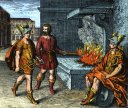 | Give fire to fire. Mercury to Mercury, and it is enough for you. |
The Hypertext Declaration of Independence
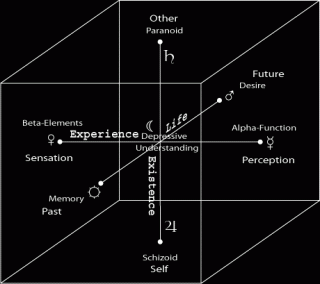
| Here we map some of Bion's primary formulations to the Cube of Psychological Space. This requires a revision of PS<->D (paranoid-schizoid and depressive positions), since we can now see that it is really more like P-><-D-><-S. The integrative-depressive work of the psyche is performed between the paranoid (other) and schizoid (self) poles of the existential axis from birth. Bion described the oscilation of developmental position with his double arrow and thought it the basis for psychological growth.
We recognize Bion's trinity of memory, desire and understanding as the life axis of the Cube (future-past) with the work of understanding centered between memory and desire. And the response of alpha function to the presence of beta elements as the axis of experience (sense-perception). Bion is the most mystical of analytic theorists because he leaves a place for ultimate unknowable reality in his metapsychology. "The belief that reality is or could be known is mistaken because reality is not something that lends itself to being known ... it is impossible to know reality for the same reason that makes it impossible to sing potaoes .. Reality has to be "been"." Bion, Transformations, 1965, p.148. Alpha function is associated with awareness but is devoid of meaning. Beta elements are sensory impressions that haven't been transformed by alpha function (consciousness) and can't be stored in memory as a dream thoughts subject to recall and re-transcription. |
"The term alpha function is, intentionally, devoid of meaning.(...)it is important that it should not be prematurely used to convey meanings, for the premature meanings may be precisely those that it is essential to exclude." Bion, 1962, p.3
"Alpha-function operates on the sense impressions, whatever they are, and the emotions, whatever they are, of which the patient is aware. In so far as alpha-function is successful alpha-elements are produced and these elements are suited to storage and the requirements of dream-thoughts. If alpha-function is disturbed, and therefore inoperative, the sense impressions of which the patient is aware and the emotions which he is experiencing remain unchanged. I shall call them beta-elements. In contrast with the alpha-elements the beta-elements are not felt to be phenomena, but things in themselves. The emotions likewise are objects of sense." Bion, 1962, p.6
"Intolerance of frustration could be so pronounced that alpha-function would be forestalled by immediate evacuation of the beta-elements." Bion, 1962, p.35
July 03, 2003
Selected Fact
 | Lock the tree with the old man in a bedewed house, and, by eating of the tree's fruit, the old man becomes young. |
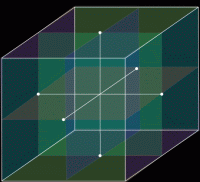
"The "selected fact", that is to say the element that gives coherence to the objects of the paranoid-depressive position, does so by virtue of its membership of a number of different deductive systems at their point of intersection. Obtrusion of the selected fact is accompanied by an emotion such as is experienced in regarding the object in reversible perspective." Bion, Seven Servants, p.87
| The selected fact is the fact that can't be selected because it will result in catastrophic change for the psyche or group. The selected fact is the fact that cannot be integrated into the current definatory hypothesis or basic belief system because its integration will cause the destruction of the container, the current definatory hypothesis maintained by mythical assumptions. |
"I have used the term ‘selected fact’ to describe that which the psycho-analyst must experience in the process of synthesis. The name of one element is used to particularise the selected fact, that is to say the name of that element in the realisation which appears to link together elements not hitherto seen to be connected... The selected fact is the name of an emotional experience, the emotional experience of a sense of discovery of coherence." Bion, Learning from Experience (chapter 23, p. 72)
"The selected fact is the name of an emotional experience, the emotional experience of a sense of discovery of coherence; its significance is therefore epistemological and the relationship of selected facts must not be assumed to be logical." (Bion, 1962, p.73).
"Bion's contribution to the understanding of creativity is intrinsic to his 'theory of thinking' (1962). He conceived the thinking apparatus as the 'container-contained' - which was operated upon by the dynamic influence of the paranoid-schizoid (PS) and depressive positions (D), plus the 'selected fact' -akin to a catalyst. This process he termed 'PS<-> D' with the double arrow suggesting an ongoing oscillation between the two positions.
. . .
In the creative process, Bion shows that thinking involves the dismantling of previous views and theories, allowing the formation of new ideas. In changing one's way of thinking, the container has to be dissolved before it is reformed. Bion regarded the effort of dissolution as having the quality of a small psychic catastrophe, a "going-to-pieces". It was therefore a movement into the paranoid-schizoid position. The re-forming of a new set of views and theories is a synthesising move like that of the depressive position. Creative effort can therefore be viewed as an on-going process, on a small scale, of movements to-and-fro between the paranoid-schizoid and depressive position."
Nicola Glover: "Chapter Four: The Legacy of Wilfred Bion
Clay Shirky: A Group Is Its Own Worst Enemy
Sonia Neves Langlands: Magic Eye and Binocular Vision: What, According to Bion, are the Pre-conditions of the Phenomenon of "Insight"?
Authors and quotations: Wilfred R. Bion - Vera Rita de Melo Ferreira
It is only through the influence of individuals who can set an example and whom masses recognize as their leaders that they can be induced to perform the work and undergo the renunciations on which the existence of civilization depends. All is well if these leaders are persons who possess superior insight into the necessities of life and who have risen to the height of mastering their own instinctual wishes. But there is a danger that in order not to lose their influence they may give way to the mass more than it gives way to them, and it therefore seems necessary that they will be independent of the mass by having means to power at their disposal. Freud Abtracts